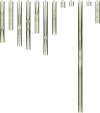Identification of fruit size associated quantitative trait loci featuring SLAF based high-density linkage map of goji berry (Lycium spp.)
- PMID: 33059596
- PMCID: PMC7565837
- DOI: 10.1186/s12870-020-02567-1
Identification of fruit size associated quantitative trait loci featuring SLAF based high-density linkage map of goji berry (Lycium spp.)
Abstract
Background: Goji (Lycium spp., 2n = 24) is a fruit bearing woody plant popular as a superfood for extensive medicinal and nutritional advantages. Fruit size associated attributes are important for evaluating small-fruited goji berry and plant architecture. The domestication traits are regulated quantitatively in crop plants but few studies have attempted on genomic regions corresponding to fruit traits.
Results: In this study, we established high-resolution map using specific locus amplified fragment (SLAF) sequencing for de novo SNPs detection based on 305 F1 individuals derived from L. chinense and L. barbarum and performed quantitative trait loci (QTL) analysis of fruit size related traits in goji berry. The genetic map contained 3495 SLAF markers on 12 LGs, spanning 1649.03 cM with 0.47 cM average interval. Female and male parents and F1 individuals` sequencing depth was 111.85-fold and 168.72-fold and 35.80-fold, respectively. The phenotype data were collected for 2 successive years (2018-2019); however, two-year mean data were combined in an extra year (1819). Total 117 QTLs were detected corresponding to multiple traits, of which 78 QTLs in 2 individual years and 36 QTLs in extra year. Six Promising QTLs (qFW10-6.1, qFL10-2.1, qLL10-2.1, qLD10-2.1, qLD12-4.1, qLA10-2.1) were discovered influencing fruit weight, fruit length and leaf related attributes covering an interval ranged from 27.32-71.59 cM on LG10 with peak LOD of 10.48 and 14.6% PVE. Three QTLs targeting fruit sweetness (qFS3-1, qFS5-2) and fruit firmness (qFF10-1) were also identified. Strikingly, various traits QTLs were overlapped on LG10, in particular, qFL10-2.1 was co-located with qLL10-2.1, qLD10-2.1 and qLA10-2.1 among stable QTLs, harbored tightly linked markers, while qLL10-1 was one major QTL with 14.21 highest LOD and 19.3% variance. As LG10 harbored important traits QTLs, we might speculate that it could be hotspot region regulating fruit size and plant architectures.
Conclusions: This report highlights the extremely saturated linkage map using SLAF-seq and novel loci contributing fruit size-related attributes in goji berry. Our results will shed light on domestication traits and further strengthen molecular and genetic underpinnings of goji berry; moreover, these findings would better facilitate to assemble the reference genome, determining potential candidate genes and marker-assisted breeding.
Keywords: Fruit size; Goji; High-density genetic map; Interspecific; QTL mapping; SLAF-seq.
Conflict of interest statement
All authors declare no competing financial interest.
Figures





Similar articles
-
A consensus and saturated genetic map provides insight into genome anchoring, synteny of Solanaceae and leaf- and fruit-related QTLs in wolfberry (Lycium Linn.).BMC Plant Biol. 2021 Jul 24;21(1):350. doi: 10.1186/s12870-021-03115-1. BMC Plant Biol. 2021. PMID: 34303361 Free PMC article.
-
Mapping quantitative trait loci associated with self-(in)compatibility in goji berries (Lycium barbarum).BMC Plant Biol. 2024 May 23;24(1):441. doi: 10.1186/s12870-024-05092-7. BMC Plant Biol. 2024. PMID: 38778301 Free PMC article.
-
Novel stable QTLs identification for berry quality traits based on high-density genetic linkage map construction in table grape.BMC Plant Biol. 2020 Sep 3;20(1):411. doi: 10.1186/s12870-020-02630-x. BMC Plant Biol. 2020. PMID: 32883214 Free PMC article.
-
The genetic basis of fruit morphology in horticultural crops: lessons from tomato and melon.J Exp Bot. 2014 Aug;65(16):4625-37. doi: 10.1093/jxb/eru017. Epub 2014 Feb 11. J Exp Bot. 2014. PMID: 24520021 Review.
-
Unveiling the components, physiological functions and emerging trends of hydroxycinnamic acid amides in goji berry (Lycium).Food Res Int. 2025 Aug;214:116696. doi: 10.1016/j.foodres.2025.116696. Epub 2025 May 19. Food Res Int. 2025. PMID: 40467257 Review.
Cited by
-
Construction of the first high-density genetic linkage map and QTL mapping of flavonoid and leaf-size related traits in Epimedium.BMC Plant Biol. 2023 May 25;23(1):278. doi: 10.1186/s12870-023-04257-0. BMC Plant Biol. 2023. PMID: 37231361 Free PMC article.
-
Quantitative Trait Loci Mapping and Development of KASP Marker Smut Screening Assay Using High-Density Genetic Map and Bulked Segregant RNA Sequencing in Sugarcane (Saccharum spp.).Front Plant Sci. 2022 Jan 5;12:796189. doi: 10.3389/fpls.2021.796189. eCollection 2021. Front Plant Sci. 2022. PMID: 35069651 Free PMC article.
-
Genomic Analysis of Romanian Lycium Genotypes: Exploring BODYGUARD Genes for Stress Resistance Breeding.Int J Mol Sci. 2024 Feb 9;25(4):2130. doi: 10.3390/ijms25042130. Int J Mol Sci. 2024. PMID: 38396806 Free PMC article.
-
A High-Density Genetic Map Enables Genome Synteny and QTL Mapping of Vegetative Growth and Leaf Traits in Gardenia.Front Genet. 2022 Jan 4;12:802738. doi: 10.3389/fgene.2021.802738. eCollection 2021. Front Genet. 2022. PMID: 35132310 Free PMC article.
-
The cytological basis of self-incompatibility in goji (Lycium barbarum) and the cloning of S-RNase gene.Planta. 2025 Jun 19;262(2):33. doi: 10.1007/s00425-025-04753-7. Planta. 2025. PMID: 40536558
References
-
- Amagase H, Farnsworth NR. A review of botanical characteristics, phytochemistry, clinical relevance in efficacy and safety of Lycium barbarum fruit (goji) Food Res Int. 2011;44(7):1702–1717. doi: 10.1016/j.foodres.2011.03.027. - DOI
-
- Wang CC, Chang SC, Inbaraj BS, Chen BH. Isolation of carotenoids, flavonoids and polysaccharides from Lycium barbarum L. and evaluation of the antioxidant activity. Food Chem. 2010;120:184–192. doi: 10.1016/j.foodchem.2009.10.005. - DOI
MeSH terms
Grants and funding
- 2018YFD1000607/National Key R&D Program of China
- 31770334/National Natural Science Foundation of China
- 2015286/Youth Innovation Promotion Association CAS
- 201904010167/Science and Technology Program of Guangzhou
- XDA24030502, XDA13020604/Strategic and Priority Research Program of Chinese Academy of Sciences
LinkOut - more resources
Full Text Sources
Research Materials
Miscellaneous

